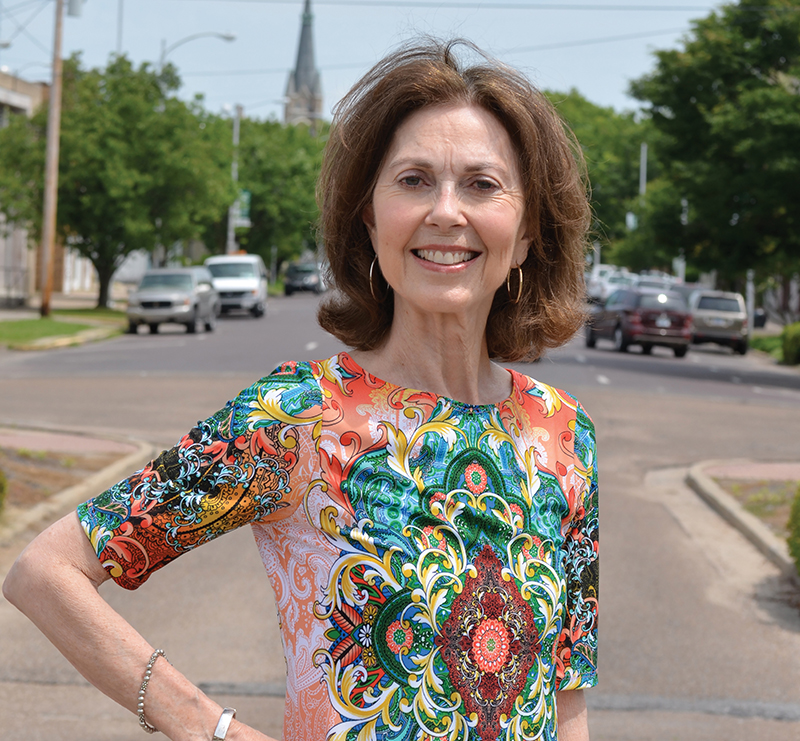Cameron recalls highlight of job as Greenville Main Street Director
By Becky Gillette
Betty Lynn Cameron recalls one of the highlights of her 18 years working in economic development for the Chamber of Commerce and later as Greenville Main Street Director. It was the day after the first Delta Hot Tamale Festival in Steinmart Square, the center of a downtown renaissance.
The day after the first Hot Tamale Festival, Cameron was sitting at Steinmart Square watching her granddaughters play. Cameron greeted two local women walking in the Square. One of the women replied, “Yes it is, but you should have been here yesterday. We had a festival. And it was covered with people smiling and happy, black and white, young and old. It was the happiest day in a long time in Greenville.”
“Tears started running down my cheeks as the two women continued walking,” Cameron says. “This is exactly what we were trying to accomplish, making people excited about Greenville again. Everyone was eating hot tamales, smiling and happy.”
Cameron has worked hard to make people proud of downtown Greenville again. She was a chief organizer for the Hot Tamale Festival and the impetus behind trademarking Greenville as “The Hot Tamale Capital of the World.”
“We heard so much negative from people who grew up here, who didn’t want to bring friends and families back here because they were ashamed of it,” Cameron says, who retired as Greenville Main Street Director in February. “We started the Hot Tamale Festival as a way to create an atmosphere that would draw people into Greenville and the Delta to have a good time. After all, you can’t say hot tamale without smiling.”
Downtown Greenville was once a retail mecca for not just Greenville and Washington County, but a three-state area. But after the mall went in on Highway 1, most of the bigger and more viable stores either closed or moved to the mall. The downtown’s problems got even worse with an “urban renewal” program in the early 1970s that redesigned streets so they curved and added street trees and other landscaping. After that flopped, in the late 1990s the streets were straightened out again, and the trees cut down—again, a “solution” that had drawbacks.
“When they removed all the beautiful trees, the boarded-up buildings were even more pronounced,” she says. “It was not a pretty sight. It looked like Greenville was dying. When I was at the chamber, we started the campaign ‘Believe in Greenville.’ It was started to show that the people who live here still believe in Greenville and are going to make it work. I still see a lot of bumper stickers that say, ‘Believe in Greenville’.”
Greenville Main Street has been involved in many other projects designed to make people feel warm and welcome. With the help of the garden clubs, murals were painted on boarded-up buildings that made them look like stores and restaurants. Local volunteer Charlene Louwerens donated her time and talent to design and paint the murals.
“The murals were very successful because you didn’t just see the boarded up buildings, but could see what they could be,” Cameron says. “Eight or nine murals were done about three years ago. In 2011, the Main Street Design Committee decided to upgrade the blighted area that is the historic site of the very first Steinmart store. Main Street started the process of making it a “green space” in 2011. That was the year friends of mine, Valerie Lee Rankin and Anne Martin, and I decided to have a Hot Tamale Festival.”
That first year the festival drew 5,000. That number grew to 20,000 the fourth year.
Another favorable factor was when a former Greenvillian, Ken Dowe, issued a $50,000 challenge match grant for revitalization of Greenville. Main Street facilitated the Greenville Challenge project, raising the matching $50,000 not from large corporate donors, but regular residents.
“We wanted everyone to have ownership of the project, and it worked out well,” she says. “We raised the matching money in about ninety days. Lynn Cox was a volunteer in coordinating the grant application process.”
The challenge money has been used in many areas. The Greenville Rising Project, chaired by volunteers Lee Harris and Beth Mansour, helped downtown property owners spruce up.
Other highlights include the façade grant program funded by the city that was used to renovate about 15 façades in the past eight years. Bringing in experts from Mississippi Main Street helped local entrepreneurs hone in on a vision of how to bring the downtown alive.
Cameron finds it exciting to see businesses opening and expanding downtown. Across from Steinmart Square, a building has been renovated to house a new downtown business, and the adjoining building has been renovated tenant-ready. Also, a local developer is currently renovating a three-story downtown building, originally a Sears and Roebuck store, into high-end apartments and a boutique hotel, along with a microbrewery and retail space.
“It is going to be awesome,” Cameron says. “It will probably be finished by the end of the year. Downtown has really come a long way since the 1980s. Al Brock, former board chairman, and avid Main Street volunteer, was my back in my years at Main Street.”
Special events play a major part in bringing people into the downtown area. Additional ones coordinated by Cameron include the Greenville Farmers Market, July 4 Greenville Celebrates America, Miss. Delta Dragon Boat Festival and the Greenville Christmas Parade.
“It has been very rewarding in so many ways,” she says. “My retiring has been real emotional. But it is time for some fresh energy. I’m chilling out for a while, but after a while I will be looking for a new challenge and will continue to be involved in community development. Downtown Greenville is definitely rising and moving forward.”

